Release Mode
Choosing a Release Mode
To choose the operation performed when the shutter-release button is pressed all the way down, hold the
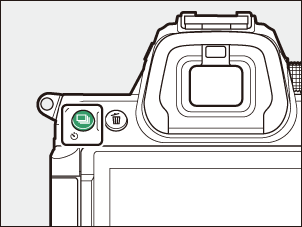
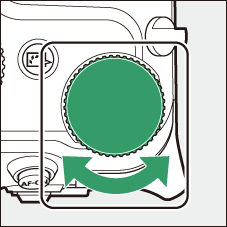
- Options for the selected setting, if any, can be chosen by holding the c (E) button and rotating the sub-command dial.
| Mode | Description | |
|---|---|---|
| [ |
The camera takes one photograph each time the shutter-release button is pressed. | |
| [ |
The camera takes photographs at a selected rate while the shutter-release button is pressed.
|
|
| [ |
The camera takes photographs at up to 9.4 fps (up to 10 fps in silent mode) while the shutter-release button is pressed. |
|
| [ |
The camera takes photographs at up to 14 fps (up to 15 fps in silent mode) while the shutter-release button is pressed. |
|
| [ |
The camera takes photographs at 15 or 30 fps while the shutter-release button is pressed (0 High-Speed Frame Capture + (C15/C30)). | |
| [ |
||
| [ |
Take pictures with the self-timer (0 Using the Self-Timer (E)). | |
Burst Photography
For burst photography, hold the c (E) button and rotate the main command dial to select [Continuous L], [Continuous H], or [Continuous H (extended)].


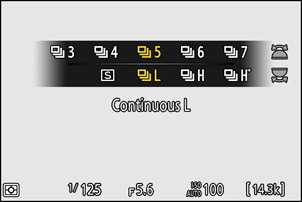
Frame Advance Rate
The maximum frame advance rates for [Continuous H] and [Continuous H (extended)] vary by camera settings. The maximum frame advance rates for each setting are as follows:
| Release mode | Image quality | Shutter type | [Silent mode]: [ON] | |
|---|---|---|---|---|
| Mechanical shutter | Electronic front-curtain shutter | |||
| [Continuous H] | NEF (RAW)/NEF (RAW) + | Approx. 6.9 fps | Approx. 8.2 fps | Approx. 6.5 fps |
| JPEG/HEIF | Approx. 7.8 fps | Approx. 9.4 fps | Approx. 10 fps | |
| [Continuous H (extended)] | NEF (RAW)/NEF (RAW) + | Approx. 11 fps | Approx. 8.3 fps | |
| JPEG | Approx. 14 fps | Approx. 15 fps | ||
The Memory Buffer
While the shutter-release button is pressed halfway, the frame-count display will show the number of pictures that can be stored in the memory buffer as “rXXX.” “XXX” indicates the number of pictures that can be taken in a burst with the current camera settings. For example, if “r050” is displayed, the camera can hold 50 pictures in the memory buffer with the current settings.
- The number shown is an approximate. The actual number of photos that can be stored in the memory buffer varies by camera settings and shooting conditions.
- The buffer capacity is also displayed while the shutter-release button is pressed all the way down.
- The camera temporarily stores the pictures taken in the memory buffer before saving them to the memory card. The number of pictures that can be taken in the current burst will be displayed according to the available space in the memory buffer.
- When the display shows “r000,” the frame rate will drop.
- The number of photos that can be stored in the memory buffer also appears while the single frame or self-timer mode is selected.
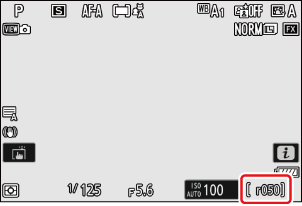
- The camera may be unable to maintain consistent exposure across each burst at some settings. For consistent exposure across all the shots in each burst, use autoexposure lock (0 Autoexposure (AE) Lock).
- The frame advance rate for [Continuous H (extended)] drops to that for [Continuous H] when [HLG] is selected for [Tone mode] in the photo shooting menu.
- Depending on shooting conditions and memory card performance, the memory card access lamp may light for anywhere from a few tens of seconds to around a minute. Do not remove the memory card while the memory card access lamp is lit. Not only could any unrecorded pictures be lost, but the camera or memory card could be damaged.
- If the camera is switched off while the memory card access lamp is lit, it will not power off until all pictures in the buffer have been recorded.
- If the battery is exhausted while pictures remain in the buffer, the shutter release will be disabled and the pictures transferred to the memory card.
High-Speed Frame Capture + (C15 /C30 )
For high-speed burst photography at frame rates of 15 or 30 fps (high-speed frame capture +), hold the c (E) button and rotate the main command dial to choose [C15] or [C30].


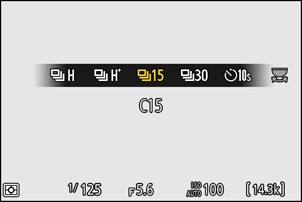
- The maximum length of bursts taken using high-speed frame capture + varies with the frame rate.
- The photos recorded may also include the final pictures from frames buffered while the shutter-release button is pressed halfway (“Pre-Release Capture”); to choose how much of the buffer is saved, use Custom Setting d3 [Pre-Release Capture options]. You can also limit the length of the burst recorded after the shutter-release button is pressed all the way down (0 d3: Pre-Release Capture options).
- The touch shutter can be used only to take one picture at a time. Use the shutter-release button for high-speed frame capture +.
High-Speed Frame Capture +: Restrictions
Only the [FX (36×24)] and [DX (24×16)] image area options are available.
- Image quality is fixed at [JPEG/HEIF normal] and pictures are recorded in JPEG format.
- Image size is fixed at [Large].
Shutter speed can only be set to values between ¹⁄₈₀₀₀ s and ¹/₆₀ s.
- Exposure compensation is restricted to values between −3 and +3 EV, although settings between −5 and +5 EV can be selected.
- The upper limit for ISO sensitivity is ISO 64000, even when higher values (Hi 0.3 through Hi 1.7) are selected.
- The option chosen for [Minimum shutter speed] will not apply if [ON] is selected for [ISO sensitivity settings] > [Auto ISO sensitivity control] in the photo shooting menu.
High-speed frame capture + cannot be combined with some camera features, including:
- flexible program,
- HLG tone mode,
- photo flicker reduction,
- flash photography,
- bracketing,
- multiple exposures,
- HDR overlay,
- interval-timer photography,
- time-lapse video recording,
- focus shift, and
- pixel shift.
Memory cards with a high write speed are recommended (0 Approved Memory Cards).
Using the Self-Timer (E )
In self-timer mode, pressing the shutter-release button all the way down starts a timer, and a photo is taken when the timer expires.
Hold the c (E) button and rotate the main command dial to select E.


Hold the c (E) button and rotate the sub-command dial to choose the self-timer delay.
To focus, press the shutter-release button halfway (i.e., lightly press the shutter-release button, stopping when it is pressed halfway).
The timer will not start if the shutter cannot be released, as may be the case, for example, if the camera is unable to focus when AF‑S is selected for focus mode.

Without lifting your finger from the shutter-release button, press the button the rest of the way down to start self-timer shooting.

- The self-timer lamp will begin flashing when the shutter-release button is pressed. The lamp stops flashing two seconds before the timer expires and the camera releases the shutter.
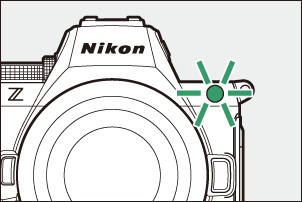
- The timer duration, the number of shots taken, and the interval between shots can be selected using Custom Setting c2 [Self-timer] (0 c2: Self-timer).
The Focus Position in Self-Timer
- In self-timer photography, the shutter releases at the selected focus position when the shutter-release button is pressed halfway in Step 3. The subject’s motion will not affect the focus position.
- In self-portrait mode, the camera will focus about a second before releasing the shutter when using the self-timer.
